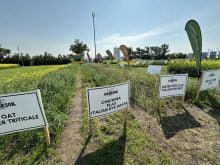Holistic management is a framework for making decisions by looking at your entire environment, including your soil and the living organisms in it, how you’re capturing rainfall and energy from the sun and the diversity of the entire biological community. It also includes taking into account the environmental, economic and social consequences of the decisions you make on your farm.
There are two main principles behind the holistic management course taught by Holistic Management International. The first is “Nature functions in wholes.” That is, you must focus on all of the relationships in an environment, not just a few factors. You can’t change one thing without impacting the entire ecosystem.
Read Also

Cancer agency reclassifies another herbicide ‘probably carcinogenic’
The WHO’s cancer research agency has now put atrazine, a herbicide well known to corn growers, in the same potential-hazard category where the agency put glyphosate.
The second principle: “Understand the environment you manage.” Different environments react differently to the same actions.
For more information, including free downloads, a free newsletter, blogs, or information about intensive courses in holistic management visit holisticmanagement.org.
Are cover crops on the rise?
Last March the U.S.-based Sustainable Agriculture Research and Education program and the Conservation Technology Information Centre worked together to survey farmers about their use of cover crops. Of the 2,020 farmers who replied to the survey, 81 per cent were using cover crops.
Those farmers using cover crops reported an increase in the number of acres they’d devoted to cover crops, and said they would be planting more in 2016. In 2012, the United States Department of Agriculture’s Ag Census reported 10.3 million acres of cover crops across the country. The next U.S. Census will not be out until next year.
When respondents were asked why they planted cover crops, the top three survey answers were: “increases overall soil health,” “reduces soil erosion,” and “increases soil organic matter.” These were the same top three answers respondents reported in last year’s survey.
When asked about the impact of cover crops on their profitability, 34 per cent of respondents reported increased profitability, 26 per cent reported no impact on their farm’s profitability, six per cent reported a profitability decrease, and 35 per cent said they didn’t yet have enough data about or experience with cover crops to tell.
Two-thirds of respondents agreed with the following statement: “Using cover crops can reduce yield variability associated with weather extremes such as strong, intense storms and droughts, etc.”
Read the full report at sare.org.














